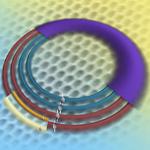05 October 2010

Photo: AP
Professor Andre Geim, left, and Dr. Konstantin Novoselov, who have been awarded the Nobel Prize for Physics, pose for pictures outside Manchester University, Manchester, England, 05 Oct 2010
Two Russian-born scientists have won the Nobel Prize for Physics for their discovery of a material that could affect computers, phones, security devices and medical research. Andre Geim and Konstantin Novoselov's discovery of graphene earned them the 2010 Nobel Prize and their discovery could have wide-ranging uses.
It started with a simple experiment: take some graphite - the black stuff in the middle of a pencil - and put a piece of tape over it. When the scientists at the University of Manchester did that, they found that they could develop a material that conducts electricity well, is extremely strong, and is thin enough to see through.
Andre Geim and Konstantin Novoselov's work focused on the properties of graphene and that led to Tuesday's announcement by Staffan Normark in Stockholm.
"The Royal Swedish Academy of Sciences has decided to award the Nobel Prize in Physics jointly to Professor Andre Geim and Professor Konstantin Novoselov, both at the University of Manchester, United Kingdom. And the Academy citation runs 'for groundbreaking experiments regarding the two-dimensional material graphene," he said.

NIST
This artist's rendition illustrates the electron energy levels in graphene as revealed by a unique NIST instrumentThinness is one of graphene's properties that make it so useful. The material is only one atom thick, but is extremely strong for its size. It also conducts electricity quickly at room temperature. Phillip Schewe is with the American Institute of Physics in College Park, Maryland. He told VOA that graphene's conductivity has implications for electronics and computers.
"Electrons, electricity move through graphene very quickly without losing much energy. And that's always a good thing, for an electronic product. You want electrons to move very quickly because all of our computers and other electronic equipment like iPhones depend on electronic gizmos that work very quickly, are very compact and cheap. And graphene looks as if it is going to fulfill all of those criteria," said Schewe.
Schewe says that graphene could also be used to make transistors in integrated circuits that could make computers cheaper and faster as well.
Graphene, a honeycomb-shaped molecule of carbon atoms, also is extremely strong for its size. Phillip Schewe says its mechanical strength and light weight make the material useful to reinforce fabrics and building materials.
"It's transparent, so if you saw a little chip of it, it would look like Saran wrap [clear plastic wrap] only much smaller and thinner," he said. "But even a single sheet of it is very strong. And if you contrive tests to compare it to other strong materials, it turns out to be about 100 times stronger than steel.
Phaeton Avouris is an IBM fellow and monitor of nanotechnology at IBM. He told VOA that graphene has implications for security and medical technology as well.
"We want to use graphene for high frequency transistors," said Avouris. "And these transistors can have applications for all kinds of communications. Wireless communications from cell phones to Wi-Fi stations to radar and also to medical and security imaging, a variety of applications that we don't even know yet because we cannot generate the kind of frequencies that graphene can generate."
For their work, Geim and Novoselov earn $1.5 million and a gold medal. Geim said Tuesday that he was shocked and surprised by the announcement but planned to go to work as usual. The Nobel committee will also hand out awards for chemistry, literature, the peace prize and economics.